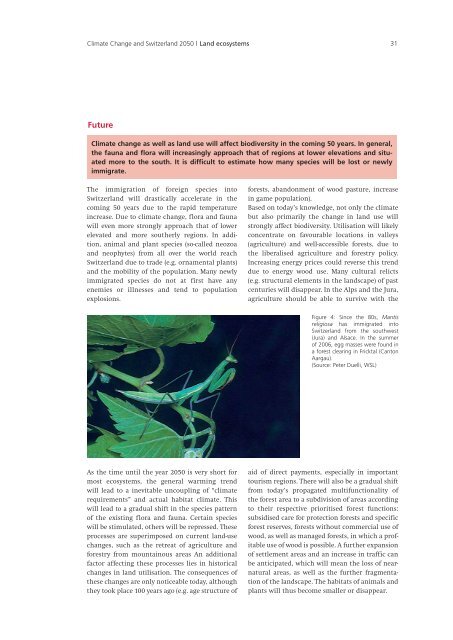Climate Change and Switzerland 2050 - OcCC - SCNAT
Climate Change and Switzerland 2050 - OcCC - SCNAT
Climate Change and Switzerland 2050 - OcCC - SCNAT
You also want an ePaper? Increase the reach of your titles
YUMPU automatically turns print PDFs into web optimized ePapers that Google loves.
<strong>Climate</strong> <strong>Change</strong> <strong>and</strong> Switzerl<strong>and</strong> <strong>2050</strong> | L<strong>and</strong> ecosystems 31<br />
Future<br />
<strong>Climate</strong> change as well as l<strong>and</strong> use will affect biodiversity in the coming 50 years. In general,<br />
the fauna <strong>and</strong> flora will increasingly approach that of regions at lower elevations <strong>and</strong> situated<br />
more to the south. It is difficult to estimate how many species will be lost or newly<br />
immigrate.<br />
The immigration of foreign species into<br />
Switzerl<strong>and</strong> will drastically accelerate in the<br />
coming 50 years due to the rapid temperature<br />
increase. Due to climate change, flora <strong>and</strong> fauna<br />
will even more strongly approach that of lower<br />
elevated <strong>and</strong> more southerly regions. In addition,<br />
animal <strong>and</strong> plant species (so-called neozoa<br />
<strong>and</strong> neophytes) from all over the world reach<br />
Switzerl<strong>and</strong> due to trade (e.g. ornamental plants)<br />
<strong>and</strong> the mobility of the population. Many newly<br />
immigrated species do not at first have any<br />
enemies or illnesses <strong>and</strong> tend to population<br />
explosions.<br />
As the time until the year <strong>2050</strong> is very short for<br />
most ecosystems, the general warming trend<br />
will lead to a inevitable uncoupling of “climate<br />
requirements” <strong>and</strong> actual habitat climate. This<br />
will lead to a gradual shift in the species pattern<br />
of the existing flora <strong>and</strong> fauna. Certain species<br />
will be stimulated, others will be repressed. These<br />
processes are superimposed on current l<strong>and</strong>-use<br />
changes, such as the retreat of agriculture <strong>and</strong><br />
forestry from mountainous areas An additional<br />
factor affecting these processes lies in historical<br />
changes in l<strong>and</strong> utilisation. The consequences of<br />
these changes are only noticeable today, although<br />
they took place 100 years ago (e.g. age structure of<br />
forests, ab<strong>and</strong>onment of wood pasture, increase<br />
in game population).<br />
Based on today’s knowledge, not only the climate<br />
but also primarily the change in l<strong>and</strong> use will<br />
strongly affect biodiversity. Utilisation will likely<br />
concentrate on favourable locations in valleys<br />
(agriculture) <strong>and</strong> well-accessible forests, due to<br />
the liberalised agriculture <strong>and</strong> forestry policy.<br />
Increasing energy prices could reverse this trend<br />
due to energy wood use. Many cultural relicts<br />
(e.g. structural elements in the l<strong>and</strong>scape) of past<br />
centuries will disappear. In the Alps <strong>and</strong> the Jura,<br />
agriculture should be able to survive with the<br />
Figure 4: Since the 80s, Mantis<br />
religiosa has immigrated into<br />
Switzerl<strong>and</strong> from the southwest<br />
(Jura) <strong>and</strong> Alsace. In the summer<br />
of 2006, egg masses were found in<br />
a forest clearing in Fricktal (Canton<br />
Aargau).<br />
(Source: Peter Duelli, WSL)<br />
aid of direct payments, especially in important<br />
tourism regions. There will also be a gradual shift<br />
from today’s propagated multifunctionality of<br />
the forest area to a subdivision of areas according<br />
to their respective prioritised forest functions:<br />
subsidised care for protection forests <strong>and</strong> specific<br />
forest reserves, forests without commercial use of<br />
wood, as well as managed forests, in which a profitable<br />
use of wood is possible. A further expansion<br />
of settlement areas <strong>and</strong> an increase in traffic can<br />
be anticipated, which will mean the loss of nearnatural<br />
areas, as well as the further fragmentation<br />
of the l<strong>and</strong>scape. The habitats of animals <strong>and</strong><br />
plants will thus become smaller or disappear.

















